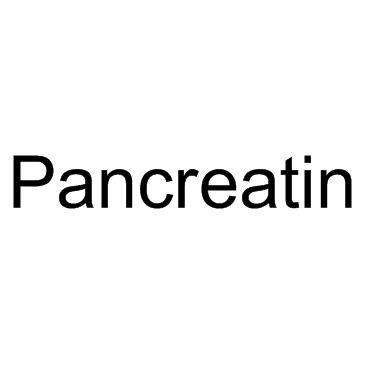胰酶

胰酶结构式

|
常用名 | 胰酶 | 英文名 | Pancreatin |
|---|---|---|---|---|
| CAS号 | 8049-47-6 | 分子量 | 300.435 | |
| 密度 | 1.0±0.1 g/cm3 | 沸点 | 462.8±14.0 °C at 760 mmHg | |
| 分子式 | C20H28O2 | 熔点 | N/A | |
| MSDS | 中文版 美版 | 闪点 | 350.6±11.0 °C | |
| 符号 |


GHS07, GHS08 |
信号词 | Danger |
胰酶用途Pancreatin 是含有主要胰腺消化酶的猪胰腺提取物 (PPE)。 |
| 中文名 | 胰酶 |
|---|---|
| 英文名 | Pancreatin |
| 中文别名 | 胰酶制剂 | 胰液素 | 胰消化素 | 胰酶 | 胰酵素 | 胰腺酶 | 胰液素,从猪胰所得(活性,4XJP) |
| 英文别名 | 更多 |
| 描述 | Pancreatin 是含有主要胰腺消化酶的猪胰腺提取物 (PPE)。 |
|---|---|
| 相关类别 | |
| 体外研究 | 胰酶是猪胰腺提取物(PPE),含有主要的胰腺消化酶。当胰酶从150增加到900 USP U/mL时,在pH 6.5下滴定的游离脂肪酸(FFA)的量分别增加了120和28%,以及脂肪分解的总程度。分别增加了79%和28%的II-LC和IIIA-LC。通过将胰酶活性从150增加到900 USPU/mL,LC-LBF的平均消化总量增加了51%,而在pH 6.5下检测到的FFA的量平均增加了55%。随着胰酶水平的增加,也观察到消化程度的增加[1]。 |
| 参考文献 |
| 密度 | 1.0±0.1 g/cm3 |
|---|---|
| 沸点 | 462.8±14.0 °C at 760 mmHg |
| 分子式 | C20H28O2 |
| 分子量 | 300.435 |
| 闪点 | 350.6±11.0 °C |
| 精确质量 | 300.208923 |
| LogP | 6.83 |
| 外观性状 | powder | beige |
| 蒸汽压 | 0.0±2.5 mmHg at 25°C |
| 折射率 | 1.556 |
| 储存条件 | 用内衬聚乙烯袋的牛皮纸袋包装。贮存于阴凉、通风、干燥的库房内。防潮,防湿,防日晒。 |
| 稳定性 | Stable. Incompatible with alcohols, strong acids. |
| 水溶解性 | Soluble or partly soluble in water forming a slightly turbid solution; practically insoluble in ethanol (96%) and in ether . | Soluble in water. Insoluble in alcohol and ether. |
| 更多 | 1. 性状:为淡黄色或白色粉末。 2. 密度(g/mL 25ºC):未确定
3. 相对蒸汽密度(g/mL,空气=1):未确定 4. 熔点(ºC常压):未确定 5. 沸点(ºC,常压):未确定 6. 沸点(ºC,5.2kPa):未确定 7. 折射率(n20/D):未确定 8. 闪点(ºC,):未确定 9. 比旋光度(º):未确定 10. 自燃点或引燃温度(ºC):未确定 11. 蒸气压(kPa,25ºC):未确定 12. 饱和蒸气压(kPa,60ºC):未确定 13. 燃烧热(KJ/mol):未确定 14. 临界温度(ºC):未确定 15. 临界压力(KPa):未确定 16. 油水(辛醇/水)分配系数的对数值(25℃):未确定 17. 爆炸上限(%,V/V):未确定 18. 爆炸下限(%,V/V):未确定 19. 溶解性(mg/mL) :能溶于水及低浓度乙醇液中,不溶于高浓度乙醇、丙酮和乙醚等有机溶剂中。 |
| 符号 |


GHS07, GHS08 |
|---|---|
| 信号词 | Danger |
| 危害声明 | H315-H319-H334-H335 |
| 警示性声明 | P261-P284-P304 + P340-P305 + P351 + P338-P342 + P311 |
| 危害码 (欧洲) | Xn |
| 风险声明 (欧洲) | 36/37/38-42-42/43 |
| 安全声明 (欧洲) | S24;S26;S36/S37;S37/S39 |
| 危险品运输编码 | NONH for all modes of transport |
| WGK德国 | 1 |
| RTECS号 | RT9033000 |
1.将动物胰脏(主要为猪的,也可用牛、羊、鸡或鸭的)搅碎,然后经过磨浆、烘干,再经乙醚浸取脱脂、粉碎后,加入适量的元明粉即为成品。
动物胰脏搅碎磨浆烘干脱脂↓乙醚
粉碎混拼↓元明粉成品
2.
|
ATG16L1 phosphorylation is oppositely regulated by CSNK2/casein kinase 2 and PPP1/protein phosphatase 1 which determines the fate of cardiomyocytes during hypoxia/reoxygenation.
Autophagy 11 , 1308-25, (2015) Recent studies have shown that the phosphorylation and dephosphorylation of ULK1 and ATG13 are related to autophagy activity. Although ATG16L1 is absolutely required for autophagy induction by affecti... |
|
|
In Vitro Evaluation of Cu, Fe, and Zn Bioaccessibility in the Presence of Babassu Mesocarp.
J. Agric. Food Chem. 63 , 6331-7, (2015) In vitro gastrointestinal digestion of babassu mesocarp in the absence and presence of milk and lignin was performed to evaluate the bioaccessibility of Cu, Fe, and Zn. Extractions using NaOH solution... |
|
|
Enzymes enhance degradation of the fiber-starch-protein matrix of distillers dried grains with solubles as revealed by a porcine in vitro fermentation model and microscopy.
J. Anim. Sci. 93 , 1039-51, (2015) Effects of treating corn and wheat distillers dried grains with solubles (DDGS) with a multicarbohydrase alone or in combination with a protease on porcine in vitro fermentation characteristics and th... |
| (9cis)-Retinoic acid |
| Alitretinoin |
| (2E,4E,6Z,8E)-3,7-dimethyl-9-(2,6,6-trimethylcyclohex-1-en-1-yl)nona-2,4,6,8-tetraenoic acid |
| 9-cis-retinoic acid |
| intrazyme |
| 9Z-retinoic acid |
| ilozyme |
| pankreon |
| 9-cis-Tretinoin |
| Retinoic acid, (9cis)- |
| beefviokase |
| diastasevera |
| panteric |
| EINECS 232-468-9 |
| pancrex-v |
| pankrotanon |
| 9(Z)-Retinoic acid |




